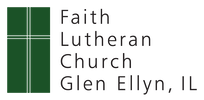Advent Activity Book
Second Week of Advent
Saturday, December 16th
Second Week of Advent
Saturday, December 16th
Our Beautiful Stained Glass Windows
Faith’s windows were designed by master craftsman, Konrad Pickel (1906-1994)
who was renown for his artful handling of brilliant color and his meaningful use
of symbols. Pickel worked with the architect, Walter Kroeber, to present a unified
design between the natural wood and the colorful windows of Faith’s building.
The windows were commissioned in 1958 during the construction of the building
and installed and dedicated in November 1959 at the cost of $14,000. There are
more than forty beautiful windows throughout our church building depicting
church seasons, sacred rituals, bible stories, and important moments in
Jesus's life and the history of Christianity.
who was renown for his artful handling of brilliant color and his meaningful use
of symbols. Pickel worked with the architect, Walter Kroeber, to present a unified
design between the natural wood and the colorful windows of Faith’s building.
The windows were commissioned in 1958 during the construction of the building
and installed and dedicated in November 1959 at the cost of $14,000. There are
more than forty beautiful windows throughout our church building depicting
church seasons, sacred rituals, bible stories, and important moments in
Jesus's life and the history of Christianity.
|
The image that appears in our coloring page is one of twelve windows that flank our sanctuary. Each windows depicts a significant event in our Lord's life, ordered with the Christian calendar year. In these windows, the artist used symbols such as the Chi Rho and the Lamb, rather than try to predict (and limit) the physical characteristics of Jesus Christ. You'll also find a cross on the right side of every window. The lower panel of each depiction includes compelling words from the scripture corresponding to each calendar season.
Presentation in the Temple
(Luke 2:21-35) The Hebrew customs of the circumcision of a male child eight days after birth and his subsequent proclamation in the temple, were observed by Mary and Joseph. These acts were a sign of acceptance into the covenant people of God. Jesus sharing the lot of humanity. The white lamb represents Jesus—the Lamb’s blood flowing into the cup depicts the sacrifice of Christ. The Lamb carries the cross and stands on a mountain indicating he will be victorious. The shell represents John the Baptist pouring the water of baptism upon Jesus. God speaks, “This is my beloved Son” to which John responded, “Behold the Lamb of God.” |
|
Creation Window
The first window visible when entering the sanctuary is the chancel window behind the altar. It consists of four panels drawing the eye upwards from bottom to top by a shaft of light. This centerpiece window depicts God's presence as a present reality. The inverted triangle of light at the top of the window symbolizes the thrust of God into human history. Two symbols at the very top, represent God as Creator (hand) and Spirit (dove). In the upper left, a shell pouring water represents Holy Baptism. At the center is the bible, the inspired Word of God. A chalice in the right center represents Holy Communion. Folded hands at the bottom left embody the human prayerful response to God's actions. In addition to the symbols, the colors of the chancel window are significant. At the top, Reds and golds represent God’s majesty coming to man. Blues and greens at the bottom represent the chaos and futility of man in a world without God.
Toward the bottom of the window, you'll see two crosses. The brightest (blue-green in color) represents the criminal crucified with Jesus, who believed in Jesus while the smaller cross (yellow-green) is for the one who did not believe. The cross representing Christ hangs not in the window, but in front of it, made of rough iron. It symbolizes Christ in our midst. He asks that we who have known him carry the cross and the message of salvation into the world. |
Photo credit Jim Nyland



